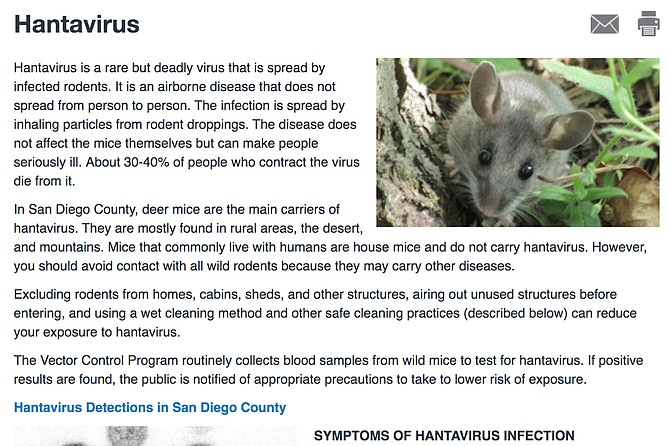 Facebook
Facebook
 X
X
 Instagram
Instagram
 TikTok
TikTok
 Youtube
Youtube

The shutdown of San Diego eateries to stem the ravages of Covid-19 may lead to at least one negative impact on health: a burgeoning rat population downtown and elsewhere. That rodents are increasingly being seen along the formerly tourist-populated waterfront, skittering across streets and sidewalks in the light of day, shouldn’t be surprising, based on national findings by the Center for Disease Control. But whether already-overwhelmed San Diego county health officials have time or the money to handle yet another pandemic-related emergency remains in question. “Jurisdictions have closed or limited service at restaurants and other commercial establishments to help limit the spread of COVID-19,” says a CDC alert regarding the growing national infestation. “Rodents rely on the food and waste generated by these establishments.”
Downtown food districts are especially vulnerable. In San Diego, rat sightings are a growing occurrence in the sprawling park surrounding the county administration building and along the nearby bayfront where the once-bustling Portside Pier is currently closed to on-premises dining. “Community-wide [restaurant] closures have led to a decrease in food available to rodents, especially in dense commercial areas. Some jurisdictions have reported an increase in rodent activity as rodents search for new sources of food.”
Traditional methods used for rat control may backfire during the present emergency, notes the agency. “Rodent bait stations may become a more attractive food source for rodents, so stations may need to be serviced more often. It is important to monitor rodent activity during this time and develop indicators to help inform rodent control strategies.”
Neglecting the rat surge can lead to other dangers, adds the notice to local health departments. “Fleas are common on rodents. In areas of heavy rodent infestations, workers should consider using a repellant registered by the U.S. Environmental Protection Agency as effective against fleas to prevent flea bites and minimize exposure to flea borne disease.”
During the 12 months between September 2019 and this past August, San Diego jumped 13 places to the 19th spot on the Rattiest Cities List maintained by the Orkin pest control company, based on the volume of rodent treatments performed. Chicago was number one, with Los Angeles second, followed by New York City.
In San Diego’s backcountry, a growing number of wild mice are carrying hantavirus, which can cause deadly lung disease when transmitted to humans. Though the virus is not spread from person to person like covid-19, “people can get infected by breathing in air contaminated after fresh rodent waste or nesting materials are stirred up,” says the Center for Disease Control. The first hantavirus-positive rodent of 2020 was a cactus mouse found on January 8 in Valley Center. The most recent, number 25, was a western harvest mouse, discovered December 18 in San Diego, according to a tally posted online by the county’s Environmental Health department. Last year’s final count was 42, with 28 cases reported in 2018 and 12 the year before. In 2018, there were only 3...

Avoiding any responsibility for San Diego’s municipal woes, ex-mayor Kevin Faulconer has hit the political road, showing up on Fox’s Tucker Carlson show, and in a Christmas Eve story in the Washington Post, which places him among “lesser luminaries” hoping to replace California Democratic governor Gavin Newsom.
A new aide to incoming San Diego city councilwoman Marni von Wilpert has provided editorial comment to his financial disclosure statement filed December 28 with the city clerk’s office. According to his LinkedIn profile, council representative Jack Hoeprich is a “marketing and public affairs professional with two years of experience working for firms and political campaigns. I help build and oversee the execution of communications and marketing plans for political candidates, business coalitions and government agencies.” But there have been a few rough spots along the way. Under an entry disclosing a $1200 gift on November 30 from Paul Daniel Hoeprich is the description “Dad helping me stay afloat.”

Besides his father, Hoeprich lists one other income source, Santa Barbara’s Rincon, LLC, which this year paid him between $10,000 and $100,000 as a Public Affairs Client Services Manager. Rincon founder Republican Chris Collier’s clients have included the Western States Petroleum Association, for which the firm has hosted online presentations, including an appearance on its Inside Corner podcast. “What are the unintended consequences of California’s energy policies? On this episode, Bob Poole of the Western States Petroleum Association discusses the role of oil and gas in our economy and how to keep our state moving.”
— Matt Potter (@sdmattpotter)
The Reader offers $25 for news tips published in this column. Call our voice mail at 619-235-3000, ext. 440, or sandiegoreader.com/staff/matt-potter/contact/.


The shutdown of San Diego eateries to stem the ravages of Covid-19 may lead to at least one negative impact on health: a burgeoning rat population downtown and elsewhere. That rodents are increasingly being seen along the formerly tourist-populated waterfront, skittering across streets and sidewalks in the light of day, shouldn’t be surprising, based on national findings by the Center for Disease Control. But whether already-overwhelmed San Diego county health officials have time or the money to handle yet another pandemic-related emergency remains in question. “Jurisdictions have closed or limited service at restaurants and other commercial establishments to help limit the spread of COVID-19,” says a CDC alert regarding the growing national infestation. “Rodents rely on the food and waste generated by these establishments.”
Downtown food districts are especially vulnerable. In San Diego, rat sightings are a growing occurrence in the sprawling park surrounding the county administration building and along the nearby bayfront where the once-bustling Portside Pier is currently closed to on-premises dining. “Community-wide [restaurant] closures have led to a decrease in food available to rodents, especially in dense commercial areas. Some jurisdictions have reported an increase in rodent activity as rodents search for new sources of food.”
Traditional methods used for rat control may backfire during the present emergency, notes the agency. “Rodent bait stations may become a more attractive food source for rodents, so stations may need to be serviced more often. It is important to monitor rodent activity during this time and develop indicators to help inform rodent control strategies.”
Neglecting the rat surge can lead to other dangers, adds the notice to local health departments. “Fleas are common on rodents. In areas of heavy rodent infestations, workers should consider using a repellant registered by the U.S. Environmental Protection Agency as effective against fleas to prevent flea bites and minimize exposure to flea borne disease.”
During the 12 months between September 2019 and this past August, San Diego jumped 13 places to the 19th spot on the Rattiest Cities List maintained by the Orkin pest control company, based on the volume of rodent treatments performed. Chicago was number one, with Los Angeles second, followed by New York City.
In San Diego’s backcountry, a growing number of wild mice are carrying hantavirus, which can cause deadly lung disease when transmitted to humans. Though the virus is not spread from person to person like covid-19, “people can get infected by breathing in air contaminated after fresh rodent waste or nesting materials are stirred up,” says the Center for Disease Control. The first hantavirus-positive rodent of 2020 was a cactus mouse found on January 8 in Valley Center. The most recent, number 25, was a western harvest mouse, discovered December 18 in San Diego, according to a tally posted online by the county’s Environmental Health department. Last year’s final count was 42, with 28 cases reported in 2018 and 12 the year before. In 2018, there were only 3...

Avoiding any responsibility for San Diego’s municipal woes, ex-mayor Kevin Faulconer has hit the political road, showing up on Fox’s Tucker Carlson show, and in a Christmas Eve story in the Washington Post, which places him among “lesser luminaries” hoping to replace California Democratic governor Gavin Newsom.
A new aide to incoming San Diego city councilwoman Marni von Wilpert has provided editorial comment to his financial disclosure statement filed December 28 with the city clerk’s office. According to his LinkedIn profile, council representative Jack Hoeprich is a “marketing and public affairs professional with two years of experience working for firms and political campaigns. I help build and oversee the execution of communications and marketing plans for political candidates, business coalitions and government agencies.” But there have been a few rough spots along the way. Under an entry disclosing a $1200 gift on November 30 from Paul Daniel Hoeprich is the description “Dad helping me stay afloat.”

Besides his father, Hoeprich lists one other income source, Santa Barbara’s Rincon, LLC, which this year paid him between $10,000 and $100,000 as a Public Affairs Client Services Manager. Rincon founder Republican Chris Collier’s clients have included the Western States Petroleum Association, for which the firm has hosted online presentations, including an appearance on its Inside Corner podcast. “What are the unintended consequences of California’s energy policies? On this episode, Bob Poole of the Western States Petroleum Association discusses the role of oil and gas in our economy and how to keep our state moving.”
— Matt Potter (@sdmattpotter)
The Reader offers $25 for news tips published in this column. Call our voice mail at 619-235-3000, ext. 440, or sandiegoreader.com/staff/matt-potter/contact/.
Comments